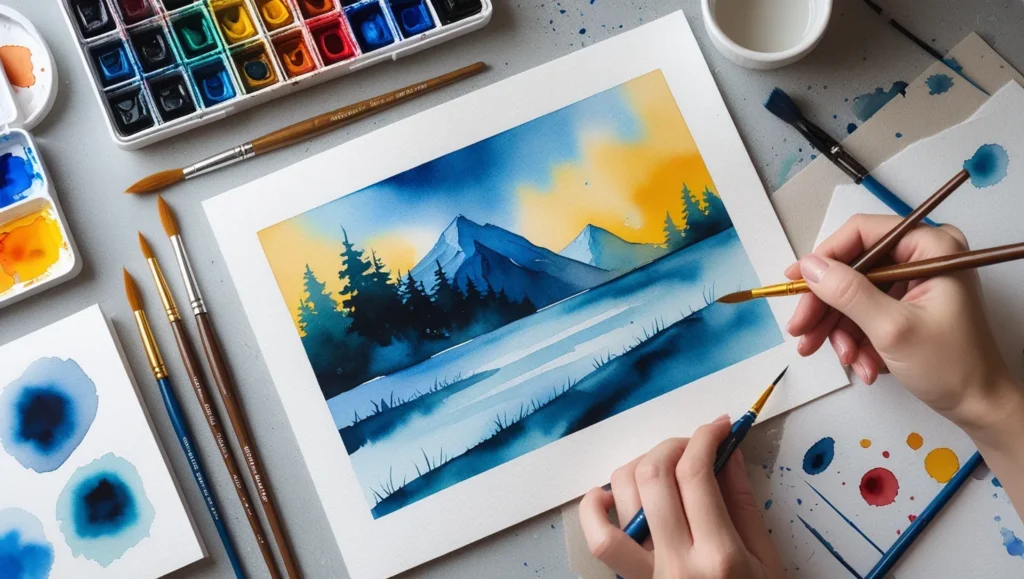Beginner’s Guide to Watercolor Painting
Watercolor painting is a beautiful and versatile medium that allows artists to create stunning works of art with a fluid, translucent quality. Whether you are a complete beginner or someone looking to refine your skills, learning the basics of watercolor painting can be both enjoyable and rewarding. This guide will introduce you to essential tools, techniques, and tips to help you get started on your watercolor journey.
Why Choose Watercolor Painting?
Watercolors are loved by artists for Beginner’s Guide to Watercolor Painting their:
- Ease of use – Simple setup and quick cleanup make it accessible for beginners.
- Transparency and vibrancy – Unique ability to create soft, glowing effects.
- Portability – Compact and lightweight, ideal for painting anywhere.
- Expressiveness – Allows for spontaneity and creative exploration.
Essential Supplies for Watercolor Painting
Before you start painting, gather the following essential materials:
1. Watercolor Paints
- Available in tubes (more vibrant and mixable) and pans (convenient for travel).
- Basic colors to start with: Ultramarine Blue, Lemon Yellow, Alizarin Crimson, Burnt Sienna, and Paynes Gray.
2. Watercolor Paper
- Cold-pressed (textured) – Best for beginners, absorbs water well.
- Hot-pressed (smooth) – Ideal for fine details and precise work.
- Weight matters – 140 lb (300 gsm) paper is recommended to prevent warping.
3. Brushes
- Round brushes (sizes 2, 6, 10) – Ideal for most techniques.
- Flat brushes – Great for washes and large areas.
- Detail brushes – For fine lines and intricate work.
4. Water and Palette
- A jar of clean water for rinsing brushes.
- A mixing palette for blending colors.
5. Additional Tools
- Masking tape – Helps keep paper in place and creates clean edges.
- Pencil and eraser – Light sketching before painting.
- Paper towels – For blotting excess water and correcting mistakes.
Basic Watercolor Techniques
1. Wet-on-Wet
- Apply water to the paper first, then add paint for soft, blended effects.
- Ideal for skies, backgrounds, and abstract washes.
2. Wet-on-Dry
- Paint directly on dry paper for sharper edges and more control.
- Best for detailed work and layering.
3. Dry Brush
- Use a dry brush with minimal water for rough textures and fine details.
- Great for adding texture to trees, rocks, and fur.
4. Lifting
- Use a damp brush or tissue to lift paint and create highlights.
- Helps correct mistakes or add texture.
5. Glazing
- Apply thin, transparent layers of paint on top of dried layers.
- Builds depth and dimension in paintings.
6. Splattering
- Flick paint using a brush or toothbrush to create texture and dynamic effects.
- Commonly used for stars, water spray, or abstract effects.
Step-by-Step Guide to Your First Watercolor Painting
1. Prepare Your Workspace
- Tape down your paper to a flat surface to prevent warping.
- Arrange your supplies within reach.
2. Lightly Sketch Your Subject
- Use a light pencil sketch to outline shapes and composition.
- Avoid pressing too hard to prevent visible pencil marks.
3. Apply the First Wash
- Start with a light wash using the wet-on-wet technique for the background.
- Let each layer dry before adding details.
4. Add Layers and Depth
- Use glazing and wet-on-dry techniques to build form and shading.
- Experiment with colors and textures to create interest.
5. Refine Details
- Use a smaller brush for finer details and textures.
- Lift highlights and add contrast where needed.
6. Finishing Touches
- Let the painting dry completely.
- Remove masking tape carefully for crisp edges.
Tips for Success
- Start Simple – Practice basic shapes and gradients before tackling complex subjects.
- Use Quality Materials – Invest in good paper and paints for better results.
- Experiment Freely – Try different techniques to discover your style.
- Be Patient – Allow layers to dry properly to avoid muddy colors.
- Practice Daily – Even 10-15 minutes a day improves skills over time.
Common Mistakes and How to Avoid Them
- Overworking the Paper – Too much scrubbing damages the paper. Work lightly Watercolor Painting.
- Using Too Much Water – Can cause uncontrolled paint spreading. Balance is key.
- Ignoring Color Mixing – Avoid using colors straight from the palette; mix for richer tones.
- Skipping Paper Choice – Thin paper warps easily; use watercolor-specific paper.
Final Thoughts
Watercolor painting is an enjoyable and rewarding artistic journey that requires Watercolor Painting patience, practice, and creativity. By understanding the essential tools, mastering basic techniques, and experimenting with different styles, beginners can gradually improve and develop their unique artistic voice. Whether painting landscapes, florals, portraits, or abstracts, watercolors offer endless possibilities for artistic expression. So, grab your brushes, start painting, and embrace the magic of watercolors!

